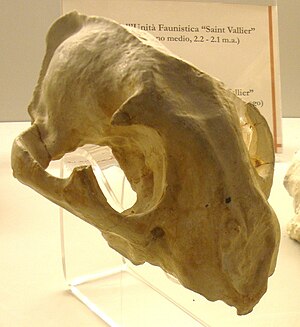Puma pardoides
| Puma pardoides | ||||||||||||
|---|---|---|---|---|---|---|---|---|---|---|---|---|

Skull of Puma schaubi = P. pardoides |
||||||||||||
| Temporal occurrence | ||||||||||||
| early Pleistocene | ||||||||||||
| 2.1 million years to 800,000 years | ||||||||||||
| Locations | ||||||||||||
|
||||||||||||
| Systematics | ||||||||||||
|
||||||||||||
| Scientific name | ||||||||||||
| Puma pardoides | ||||||||||||
| Owen , 1846 | ||||||||||||
Puma pardoides is an extinct species from the family of cats (Felidae) that was found in Eurasia in the early Pleistocene.
Puma pardoides was first described in 1846 under the name Felis pardoides by Richard Owen in England. It was only recently recognized that it is likely to be identical to the species Viretailurus schaubi (originally Panthera schaubi ) and actually belongs to the genus of puma ( Puma ). Puma pardoides is recorded from the beginning to the end of the early Pleistocene , 2,100,000 to 800,000 years ago in Europe, Georgia and Central Asia (Mongolia). The species occurred in Germany about a million years ago, and fossil remains were found in Untermaßfeld . In contrast, pumas were first recorded in America 400,000 years ago. It is therefore assumed that the genus Puma , coming from Eurasia, settled in America, where today's Puma still lives.
Puma pardoides was similar in size, sometimes a little larger than today's puma. The specimen from Untermaßfeld is estimated to be 40–45 kg, males from the earliest Pleistocene in Europe may even have weighed 60–100 kg. The typical prey animals probably included small and medium-sized ungulates such as the stag Cervus nestii , roe deer ( Capreolus ) and wild boar ( Sus scrofa ). The calves of larger deer species such as Eucladoceros are also possible prey. At the same time, several other big cats appeared in Europe, to which the European puma was certainly inferior. These included the European jaguar and the large saber-toothed cats Megantereon and Homotherium .
credentials
- ↑ Hemmer, H., Kahlike, R.-D. & Vekua, AK (2004). The Old World puma Puma pardoides (Owen, 1846) (Carnivora: Felidae) in the Lower Villafranchian (Upper Pliocene) of Kvabebi (East Georgia, Transcaucasia) and its evolutionary and biogeographical significance. New Yearbook for Geology and Paleontology, Essays 233, 197–233.
- ↑ Helmut Hemmer (2000). Out of Asia: A Paleoecological Scenario of Man and his Carnivorous Competitors in the European Pleistocene. ERAUL 92, p. 99 à 106.